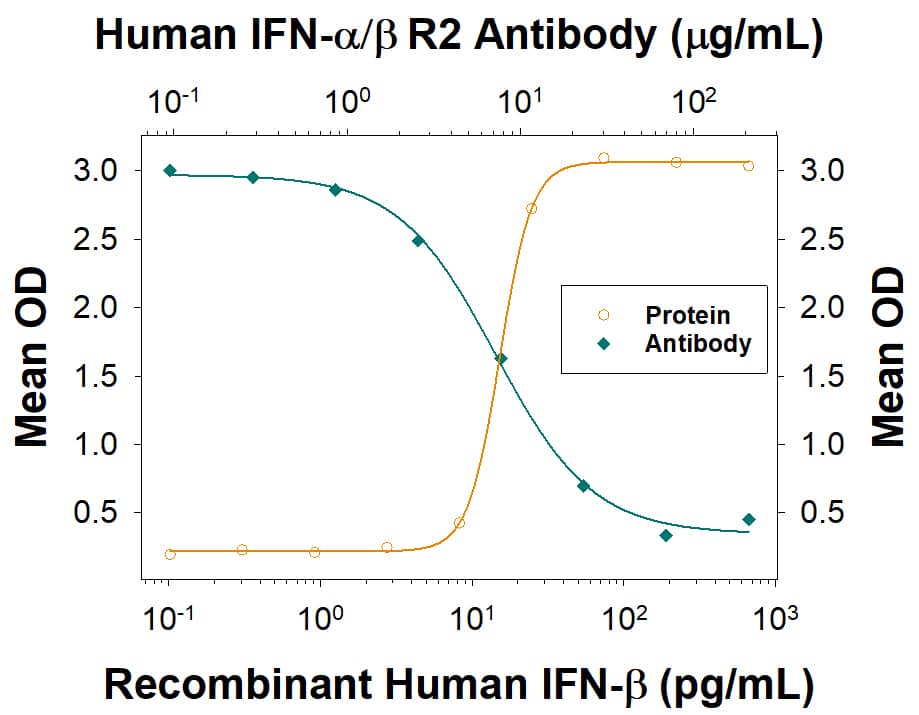Human IFN-alpha / beta R2 Antibody
R&D Systems, part of Bio-Techne | Catalog # MAB4015

Key Product Details
Species Reactivity
Validated:
Cited:
Applications
Validated:
Cited:
Label
Antibody Source
Product Specifications
Immunogen
Ile27-Lys243
Accession # P48551
Specificity
Clonality
Host
Isotype
Endotoxin Level
Scientific Data Images for Human IFN-alpha / beta R2 Antibody
IFN-beta Inhibition of EMCV-induced Cytopathy and Neutralization by Human IFN-alpha / beta R2 Antibody.
Recombinant Human IFN-beta (Catalog # 8499-IF) reduces the Encephalomyocarditis Virus (EMCV)-induced cytopathy in the HeLa human cervical epithelial carcinoma cell line in a dose-dependent manner (orange line), as measured by crystal violet staining. Inhibition of EMCV activity elicited by Recombinant Human IFN-beta (30 pg/mL) is neutralized (green line) by increasing concentrations of Mouse Anti-Human IFN-a/ beta R2 Monoclonal Antibody (Catalog # MAB4015). The ND50 is typically 4-20 µg/mL.Applications for Human IFN-alpha / beta R2 Antibody
Neutralization
Formulation, Preparation, and Storage
Purification
Reconstitution
Formulation
Shipping
Stability & Storage
- 12 months from date of receipt, -20 to -70 °C as supplied.
- 1 month, 2 to 8 °C under sterile conditions after reconstitution.
- 6 months, -20 to -70 °C under sterile conditions after reconstitution.
Background: IFN-alpha/beta R2
IFN-alpha / beta R2, also known as IFNAR2, is a 100 kDa glycoprotein in the class II cytokine receptor family. These proteins form heterodimeric receptor complexes that transduce signals from the interferon, IL-10, and IL-28 families of cytokines (1, 2). IFN-alpha / beta R2, in association with IFN-alpha / beta R1, is required for mediating the antiviral, antiproliferative, and apoptotic effects of the type I interferons IFN-alpha and IFN-beta. IFN-alpha / beta R2 is the principal ligand binding subunit of the receptor. Ligand binding is stabilized by the subsequent association with IFN-alpha / beta R1, resulting in the formation of a signaling ternary receptor complex (3, 4). Mature human IFN-alpha / beta R2 consists of a 217 amino acid (aa) extracellular domain (ECD) with two fibronectin type III repeats, a 21 aa transmembrane segment, and a 251 aa cytoplasmic domain. Alternate splicing generates a secreted isoform that corresponds to the ECD and a 50 kDa transmembrane isoform with a substituted and truncated cytoplasmic region (5, 6). The short isoform is impaired in its ability to activate signaling molecules and functions as a dominant negative receptor subunit (7-9). IFN-alpha / beta R2 is also subject to presenilin-dependent intramembrane proteolysis, resulting in the liberation of nearly the entire ECD as well as the cytoplasmic domain which migrates to the nucleus and can inhibit gene transcription (10). High concentrations of soluble IFN-alpha / beta R2 bind and neutralize IFN-alpha and IFN-beta, while lower concentrations prolong the antiviral activity of circulating IFN-beta but not IFN-alpha (11). Human but not mouse IFN-alpha / beta R2 constitutively associates with STAT4, which may account for species specific differences observed in type I interferon responses (12). Within the ECD, human IFN-alpha / beta R2 shares 63%, 60%, and 48% aa sequence identity with bovine, mouse, and ovine IFN-alpha / beta R2, respectively.
References
- Langer, J.A. et al. (2004) Cytokine Growth Factor Rev. 15:33.
- Pestka, S. et al. (2004) Immunol. Rev. 202:8.
- Lamken, P. et al. (2004) J. Mol. Biol. 341:303.
- Arduini, R.M. et al. (1999) Prot. Sci. 8:1867.
- Lutfalla, G. et al. (1995) EMBO J. 14:5100.
- Novick, D. et al. (1995) J. Leukocyte Biol. 57:712.
- Pfeffer, L.M. et al. (1997) J. Biol. Chem. 272:11002.
- Gazziola, C. et al. (2005) Int. J. Oncol. 26:129.
- Kotenko, S.V. and S. Pestka (2000) Oncogene 19:2557.
- Saleh, A.Z.M. et al. (2004) Oncogene 23:7076.
- McKenna, S.D. et al. (2004) J. Interferon Cytokine Res. 24:119.
- Tyler, D.R. et al. (2007) Mol. Immunol. 44:1864.
Long Name
Alternate Names
Gene Symbol
UniProt
Additional IFN-alpha/beta R2 Products
Product Documents for Human IFN-alpha / beta R2 Antibody
Product Specific Notices for Human IFN-alpha / beta R2 Antibody
For research use only
